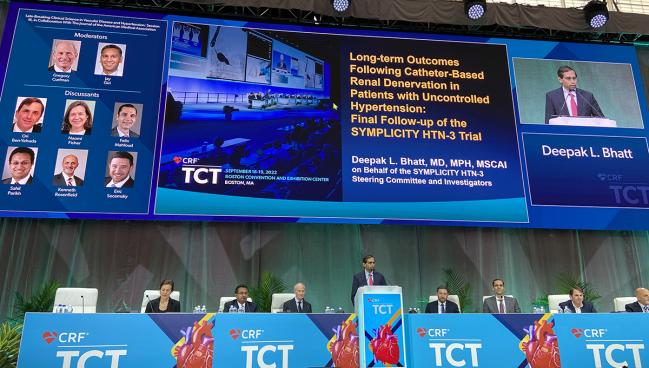SYMPLICITY HTN-3’s Late Surprise: Sustained BP Drop at 3 Years Despite Earlier Miss
Experts grappled with how to understand the positive findings given that the trial missed its primary endpoint at 6 months.

BOSTON, MA—It’s a surprise turnaround for a trial that once was poised to put the brakes on renal denervation once and for all. Long-term follow-up of hypertension patients treated with the Symplicity Flex renal denervation catheter (Medtronic) showed there were sustained reductions in systolic and diastolic blood pressure when compared with those treated with a sham procedure, results from SYMPLICITY HTN-3 show.
At 3 years, the adjusted treatment difference in office and 24-hour systolic blood pressure was 22.1 and 16.5 mm Hg, respectively, both favoring renal denervation (P < 0.0001 for both).
The impressive results, which were presented during the late-breaking science session at TCT 2022 and published simultaneously in the Lancet, have investigators and observers doing a double take, since the primary endpoint of SYMPLICITY HTN-3 was negative when it was first presented in 2014.
“You do need to be cautious,” lead investigator Deepak Bhatt, MD, MPH (Brigham and Women’s Hospital, Boston, MA), said during a morning press conference. “The SYMPLICITY HTN-3 as published in the New England Journal of Medicine didn’t show any benefit in the overall trial. I will point out that some of the blood pressure parameters, like nighttime systolic blood pressure, was significantly lower in the renal denervation arm. There were also some subgroups that looked pretty good based on patient and procedural aspects. . . . When the primary endpoint is negative, you don’t want to make too much of it.”
Despite these reservations, Bhatt believes the finding seen in long-term follow-up is real, noting there have now been several positive sham-controlled trials with newer technology, including the next-generation Spyral renal denervation catheter (Medtronic) and ultrasound-based renal denervation (Paradise; ReCor Medical).
“I do think there is something there with renal denervation,” said Bhatt. “The initial HTN-1 and HTN-2 trials with the Symplicity Flex catheter were very positive—large effects—but there were some methodological limitations. SYMPLICITY HTN-3 was the most rigorous, sham-controlled trial to date, but it probably provided an underestimate of the actual treatment effect because of a bunch of confounding factors, like the sham effect and Hawthorne effect we didn’t appreciate when we designed the trial.”
Frederick Welt, MD (University of Utah Health Sciences Center, Salt Lake City), immediate past chair of the American College of Cardiology interventional council, said the long-term follow-up of SYMPLICITY HTN-3 highlights both safety of the procedure and durability of treatment response.
“It makes me hopeful this will really find a place,” he told TCTMD. “We are parsing the data a little bit here because it was negative at its early time point, and it was a complicated trial design with all the crossover. There is also a fair number of patients lost to follow-up over time. From that standpoint, you have to take these data with a grain of salt, but the sheer magnitude of the blood pressure reduction does speak to the fact that something biologically is happening.”
Renal denervation is doing something. To what extent, and so on, that may be slightly different when more definitive trials come out. Frederick Welt
The Symplicity Flex renal denervation catheter used in the trial is no longer in use, noted Welt, with operators now using the next-generation Symplicity Spyral, a design upgrade that will hopefully continue to move the field forward.
From a ‘Grinding Halt’ to Now
The SYMPLICITY HTN-3 study was a single-blind, multicenter, randomized trial conducted at 88 centers in the US. All patients had treatment-resistant hypertension and were stable on maximally tolerated doses of three or more medications, including a diuretic. Additional inclusion criteria included office systolic blood pressure of 160 mm Hg or higher and 24-hour ambulatory systolic blood pressure of 135 mm Hg or higher.
Although the procedure was safe, an editorial accompanying the negative study when it was published famously stated that it should bring the “renal denervation train to a grinding halt.”
Since then, though, the field has continued to evolve, and several randomized trials with sham-controlled comparator groups have shown renal denervation can effectively lower systolic blood pressure. These include the SPYRAL HTN-ON MED and HTN-OFF MED studies, as well as positive data from the Global Symplicity Registry. Additionally, operators have shown positive results with the ultrasound-based renal denervation system (Paradise; ReCor Medical), such as in the short-term RADIANCE HTN-SOLO and RADIANCE HTN-TRIO studies. During the same late-breaking science session at TCT 2022, investigators presented 2-month results from RADIANCE II showing that renal denervation lowered daytime ambulatory systolic blood pressure by 7.9 mm Hg, translating into a between-group difference of 6.3 mm Hg compared with sham.
In SYMPLICITY HTN-3, patients were unmasked after the primary endpoint assessment at 6 months. At this time, patients in the sham-control arm were eligible for renal denervation if they still met the study’s entry criteria, with 101 of the original 171 patients crossing over for treatment. As part of the analysis, the blood pressure values for the crossover group were imputed as part of the control group based on their last clinical observation from 6 months.
At 36 months, there was no difference in the number of medication classes prescribed to patients, but medication burden, which was based on the drug doses per day, was significantly lower in the patients who underwent renal denervation.
In the 219 patients treated with renal denervation available for follow-up at 3 years, office systolic blood pressure was reduced 26.4 mm Hg compared with a 5.7 reduction in the 134 patients in the control arm (between-group difference 22.1 mm Hg; P < 0.0001). The between-group change in office diastolic blood pressure was 12.0 mm Hg, also a significant difference. The 24-hour ambulatory systolic blood pressure was reduced 15.6 mm Hg with renal denervation and 0.3 mm Hg in the control group, with the difference between arms statistically significant. The 24-hour change in diastolic blood pressure also favored renal denervation (between-group difference 11.2 mm Hg; P < 0.0001).
These new results, said Bhatt, show there is at minimum a preservation of the treatment effect to 3 years, and at least in real life, an amplification of benefit. Whether that’s because the control patients were no longer adhering to medical therapy or is the result of an ongoing physiologic response to renal denervation is unknown.
“Both of these things may be true,” he said. “Hopefully longer-term follow-up from a multitude of other renal denervation trials will lend insight into that.”
Welt also highlighted the analysis of patients who crossed over to renal denervation, noting that they had no change in blood pressure at 6 months but did have a continuous reduction at 3 years after they’d undergone treatment. Those who didn’t cross over had an increase in blood pressure after study unblinding. “It’s the ultimate biologic plausibility,” said Welt. “Renal denervation is doing something. To what extent, and so on, that may be slightly different when more definitive trials come out.”
Real Finding or Result of Unblinding?
Hypertension expert Naomi Fisher, MD (Brigham and Women’s Hospital), one of the panelists during the session, said some of the pharmacological treatments for high blood pressure have been around since the 1950s, with the last new drug class coming to market 15 years ago. The evidence showing support for renal denervation is welcomed because new therapies are “desperately needed,” she said.
Nonetheless, the results from SYMPLICITY HTN-3 are somewhat surprising, potentially raising some skepticism among clinicians who have been burned by the technology before. For Fisher, squaring the positive findings at 3 years with the missed primary endpoint of 2014 is ” already a little bit of a challenge for me to figure,” she said.
One of earliest explanations to account for the lack of benefit at 6 months was that the procedure, which used first-generation technology, inadequately denervated the renal arteries. But if that were the case, said Fisher, it can’t explain the improvement in blood pressure over time.
Fisher also pointed out that patients treated with renal denervation had such dramatic reductions in systolic and diastolic blood pressure they mirrored results from some of the earliest renal denervation trials, that didn’t include a sham-procedure arm. At the time, many hypertension experts considered the BP drops “too good to be true,” she said.
Data from the global registries, which include patients treated with newer-generation technology, suggest the reduction in systolic blood pressure is more modest. Medtronic, however, says they have seen “consistent long-term reductions” with renal denervation, according to a spokesperson for the company. The registry data at 3 years showed reductions in office systolic blood pressure that exceeded 23 mm Hg, for example.
Ajay Kirtane, MD (NewYork-Presbyterian/Columbia University Irving Medical Center, New York, NY), who led the RADIANCE II trial, pointed out that one of the assumptions from the SYMPLICITY HTN-3 analysis is that patients who crossed over were “frozen” at the 6-month time point in the sham arm. The current study assumes no further reductions in blood pressure in the control group who crossed over.
“That’s a pretty big assumption to make,” said Kirtane, especially when adherence to medical therapy can shift over time. This has spurred different randomized trials, including those with other renal denervation devices, to maintain the sham control “because we need to know what happens in that arm because the medications can be so variable,” said Kirtane.
Bhatt agreed with many of the comments, but said they took a rather conservative approach in their statistical breakdown of the data. They performed multiple analyses and each supported their main conclusions.
“We did analyze it in multiple ways and found remarkable consistency,” he said. Additionally, “one has to look at the totality of the data. If I was just to show the SYMPLICITY primary endpoint in the New England Journal of Medicine and these long-term data in the Lancet, you’d be right. But there are several data sources, several sham-control trials that are now showing an effect of renal denervation.”
Although it’s been 8 years since the original publication came out, Bhatt said there were a number of factors that delayed the follow-up data coming to light. He pointed out that while the comparative 3-year analysis was the focus of the new paper, they also included data on patients followed for 4.5 years. Additionally, the complexity of the analyses, along with the COVID-19 pandemic, slowed them down.
“There were multiple, statistically complex and sophisticated analyses we performed, including some using imputation techniques from recent renal denervation trials, and also some methodology that was only fully developed in the past couple of years,” he told TCTMD, citing the time in therapeutic blood-pressure range after renal denervation as an example. “The plan always was to present and publish these data, though the COVID pandemic did slow us down, but we were happy and thankful to be able to produce a final, comprehensive assessment of the safety and efficacy results from this trial.”
Michael O’Riordan is the Managing Editor for TCTMD. He completed his undergraduate degrees at Queen’s University in Kingston, ON, and…
Read Full BioSources
Bhatt DL, Vaduganathan M, Kandzari DE, et al. Long-term outcomes after catheter-based renal artery denervation for resistant hypertension: final follow-up of the randomized SYMPLICITY HTN-3 trial. Lancet 2022;Epub ahead of print.
Disclosures
- Bhatt reports serving as the co-principal investigator of SYMPLICITY HTN-3 with funding from Medtronic paid to Brigham and Women’s Hospital. He reports serving on advisory boards for AngioWave, Bayer, Boehringer Ingelheim, Cardax, CellProthera, Cereno Scientific, Elsevier Practice Update Cardiology, High Enroll, Janssen, Level Ex, McKinsey, Medscape Cardiology, Merck, MyoKardia, NirvaMed, Novo Nordisk, PhaseBio, PLx Pharma, Regado Biosciences, and Stasys. He reports honoraria from the American College of Cardiology, Arnold and Porter law firm (work related to Sanofi/Bristol-Myers Squibb clopidogrel litigation), and Baim Institute for Clinical Research. He is a member of the RE-DUAL PCI clinical trial steering committee funded by Boehringer Ingelheim, a member of the AEGIS-II executive committee funded by CSL Behring, Belvoir Publications, Canadian Medical and Surgical Knowledge Translation Research Group, Cowen and Company, Duke Clinical Research Institute, HMP Global, Journal of the American College of Cardiology, K2P, Level Ex, Medtelligence/ReachMD, MJH Life Sciences, Oakstone CME, Piper Sandler, Population Health Research Institute, Slack Publications, Society of Cardiovascular Patient Care, WebMD, and Wiley. He reports research funding from Abbott, Acesion Pharma, Afimmune, Aker Biomarine, Amarin, Amgen, AstraZeneca, Bayer, Beren, Boehringer Ingelheim, Boston Scientific, Bristol-Myers Squibb, Cardax, CellProthera, Cereno Scientific, Chiesi, CSL Behring, Eisai, Ethicon, Faraday Pharmaceuticals, Ferring Pharmaceuticals, Forest Laboratories, Fractyl, Garmin, HLS Therapeutics, Idorsia, Ironwood, Ischemix, Janssen, Javelin, Lexicon, Lilly, Medtronic, Merck, Moderna, MyoKardia, NirvaMed, Novartis, Novo Nordisk, Owkin, Pfizer, PhaseBio, PLx Pharma, Recardio, Regeneron, Reid Hoffman Foundation, Roche, Sanofi, Stasys, Synaptic, The Medicines Company, and 89Bio. He reports royalties from Elsevier for Braunwald’s Heart Disease. He is a site co-investigator for Abbott, Biotronik, Boston Scientific, CSI, Endotronix, St Jude Medical (now Abbott), Philips, SpectraWAVE, Svelte, and Vascular Solutions. He reports unfunded research from FlowCo and Takeda.
- Kirtane reports institutional funding to Columbia University and/or Cardiovascular Research Foundation from Medtronic, Boston Scientific, Abbott Vascular, Amgen, CSI, Philips, ReCor Medical, Neurotronic, Biotronik, Chiesi, Bolt Medical, Magenta Medical, Canon, and SoniVie. In addition to research grants, institutional funding includes fees paid to Columbia University and/or Cardiovascular Research Foundation for consulting and/or speaking engagements in which he controlled the content. Personal. He reports consulting for IMDS and travel expenses/meals from Medtronic, Boston Scientific, Abbott Vascular, CSI, Siemens, Philips, ReCor Medical, Chiesi, OpSens, Zoll, and Regeneron.
- Fisher reports grant/research support and/or consulting fees/honoraria from ReCor Medical, Aktiia, and Medtronic.
- Welt reports no conflicts of interest.





Comments